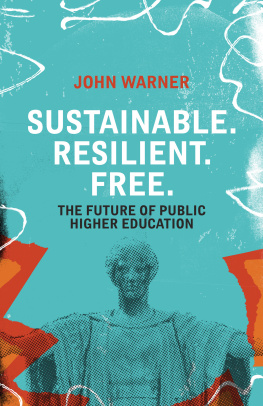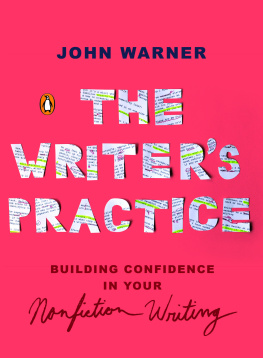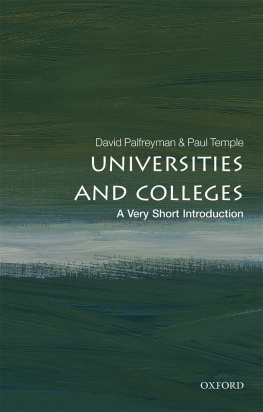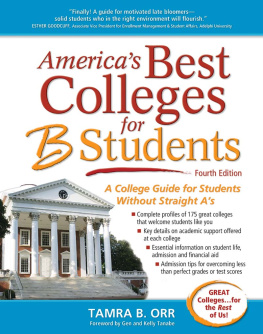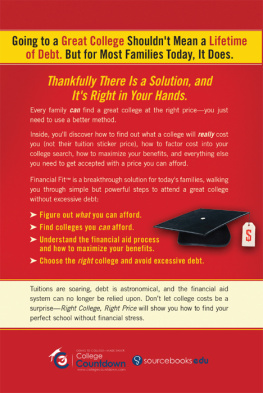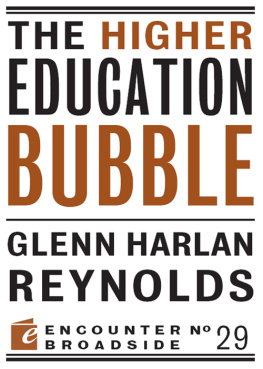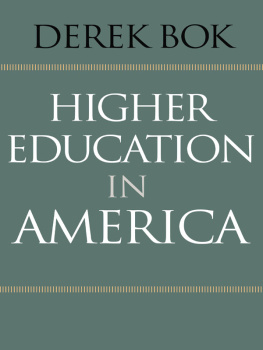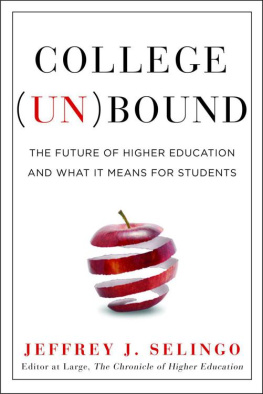
SUSTAINABLE.
RESILIENT.
FREE.
SUSTAINABLE.
RESILIENT.
FREE.
The Future of Public Higher Education
JOHN WARNER

Belt Publishing
Copyright 2020 by John Warner
All rights reserved. This book or any portion thereof may not be reproduced or used in any manner whatsoever without the express written permission of the publisher except for the use of brief quotations in a book review.
Printed in the United States of America
First edition 2020
1 2 3 4 5 6 7 8 9
ISBN: 978-1-948742-95-5
Belt Publishing
5322 Fleet Ave.
Cleveland, OH 44105
Book cover by David Wilson
Interior design by Meredith Pangrace & David Wilson
CONTENTS
PREFACE: A NEW NARRATIVE
F or almost a century, the popular narrative about college in the United States has held that a college degree is the surest route to the good life. Get a college degree, and all the rest will follow. A good job, financial security, happiness, 2.2 kids, the dog, the white picket fence you know the drill.
When I was growing up in the northern suburbs of Chicago in the seventies and eighties, the white child of two college-educated parents, no one had to sit me down and tell me this story. I lived it every day. Almost all the kids who graduated from the excellent public school I attended went on to four-year colleges and earned degrees. Same for their kids. Rinse and repeat, generation after generation.
I never had cause to question this narrative. For me, the story went exactly according to design. It all worked perfectly.
So, after twenty years teaching college, why am I now questioning a narrative that seems to work so well?
Well, for starters, this narrative is breaking down. Between 2013 and 2019, the percentage of American adults who agreed that college was very important declined from 70 percent to 51 percent. Among adults aged eighteen to twenty-nine, the population that has most recently made the choice to attend college, the decline was even sharperfrom 74 percent to 41 percent.
More importantly, though, for those people who arent part of the white middle or upper class, the narrative about higher education that worked so well for my classmates and me has never really been true in the first place. White high school graduates in America are wealthier than Black and Hispanic college graduates.resistance to their ambitions that sometimes flares into outright hostility. I recall a Black student from my first-year writing course a few years ago; she had been valedictorian of her midlands South Carolina high school and she wanted to be a doctor. But she struggled on her first biology exam, an entirely common occurrence for first-year college students who are adjusting to the demands of higher education. When she sought out extra help, however, the message she received was discouraging instead of empowering. Not everyone should major in science, she was told. What about social work?
Teaching a diverse array of students over the last twenty-plus years has revealed to me how the narrative of higher education I once believed to be trueand the one I fulfilled for myselfcame at the expense of people like that student.
Our most popular narratives about college havent progressed much beyond 1978s Animal House, a movie that was set in 1962. Neighbors, the 2014 film starring Seth Rogen and Zac Efron, is practically a remake of the John Landis film. Cinematic college is so fun that even middle-aged men (Old School, 2003) and women (Life of the Party, 2018) will do whatever it takes to recreate the experience of it. Collegeor so the Hollywood story goesis a place to party, a time in life where you can be casually and colossally irresponsible but still come out ok on the other side.
Times have changed.
The average GPA for the over 50,000 students who applied to medical school in 2018 was 3.57. For those who ultimately enrolled, the average was 3.72. When I graduated from college in 1992, with my 3.1 GPA and no particular sense of direction, I told myself that I could always go to law school if things didnt work out. And it wasnt a lie. Im not sure what I would be thinking now.
one in four students had been diagnosed with a mental health disorder the prior year; one-fifth of all students had considered suicide; one-fifth reported self-injury; and 9 percent reported having attempted suicide. For many students, rather than being a happy-go-lucky interregnum before joining the real world, as our popular and enduring fictional narratives might suggest, college is now a gauntlet to be survived.
Costs have also skyrocketed. The University of California system was tuition-free until 1968; in 1985, annual resident tuition and fees were $1,296. In 2020, even as California has the highest minimum wage of any state in the country, it would take thirty weeks.
In states with higher tuitions and lower minimum wages, things are considerably worse. At my undergraduate alma mater, the University of Illinois at Urbana-Champaign, tuition and fees range from $16,000 to nearly $22,000 a year, and the state minimum wage is $10 an hour. It could take up to a years worth of minimum-wage work to fund one year of school. When I attended between 1988 and 1992, fifteen weeks of minimum-wage workotherwise known as a summer jobwould have covered the $2,200 I needed for annual tuition and fees.
According to a study by the Hope Center for College, Community, and Justice, which they conducted during the spring 2020 disruption from the coronavirus pandemic, 44 Significant numbers of students are struggling with basic necessities. How can we possibly expect them to fund tuition costs that have risen many times faster than inflation?
As the broad narrative of college being worth it has started to crumble, other related narratives have emerged: College is worth it if you choose the right major. College is worth it if you do the first two years at a community college. You need an education and a credential, but it doesnt have to be through college.
Each of these narratives sets aside the notion that college is the pathway to success, that its the best time of your life, or that you can even work your way through to a degree. Rather, college is framed as an entry pass, a credential not for a prosperous and interesting life, but for an initial job after graduation. And if you dont choose wisely, you cant even expect to achieve that.
In every one of these new narratives, the benefits (or detriments) of college accrue entirely to the individual. It is a private goodeven a consumer goodwhose worth is literally calculated according to ones earning potential.
Colleges are about much more than this, of course. Colleges are places. They are employers and cultural hubs, institutions that serve as a locus of economic and social activity. And by allowing the narrative about higher education to become so constrained around a single goalto get that first jobwe have lost sight of this much larger role colleges play.
As I outline in the following chapters, the challenge of reorienting our public colleges and universities around a more expansive visionone that fulfills the original mission ascribed to our public universities in things like the Morrill Land-Grant Act of 1862is not a problem of money and resources. The sums necessary to enact change may seem rather large initially, but relative to other, far less vital goods our taxpayer dollars go toward, they are a relative pittance. And when those costs are weighed against the massive societal benefits that may accrue from them, it will seem foolish that we havent acted already. Rather, it is a problem of imagination. We have allowed this narrative that frames a college degree as a private good to become so enshrined that we cannot imagine it any other way. And when you throw in a global pandemic, which has upended so many of the stories we once believed to be immutably true, its become clearer than ever that some changes, which previously seemed too radical, are just common sense.
Next page
